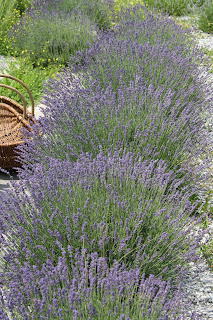Planting the new Lavandins
So this summer Andrew and I made our way to Carolee's Herb Farm, just north of Muncie Indiana. Why you ask? For lavender of course!
Every year Carolee has a weekend lavender festival where one can buy varieties not found at Lowe's or Home Depot. The first year I heard about it, I couldn't go because I had an awful sinus infection. Then, the summer after that, the extremely dry, warm spring, had the lavender blooming 6 weeks early in the midwest while on the pacific northwest coast, the plant nurseries were overwhelmed with wet weather and there were no plants to be had.
I bought two royal velvets, and they are angustfolias. Then I bought three Abriallies, three Dilly-Dillys and three Seals. These are all Lavandins. What is the difference between lavender and Lavandins?
These are Lavandins. Look, I'm standing hip-deep in them.

I would like to kindly remind you that the camera adds 10 lbs. And I would like to happily tell you that I have lost 10 lbs since this photo was taken thanks to weight training, zumba, and yoga!
Here are the baby lavandins planted 4th of July weekend.

Think of lavender, as the original plant, the wild lavender, then cultivated to a domesticated lavender, with the label “L. angustfolia.” Lavandula Intermedia plants, or the Lavandins, are hybrids of angustfolia and L. latifolia.
So what is Lavandula Latifolia? It's also knows as Spike or Spanish or Portugues Lavender and likes even warmer climates than angustfolias. Sometimes you will see a spike lavender at nurseries around here. You can tell them by their shorter/fatter heads of blooms and two little petals at the very top that stick out horizontally like ears. They won't last a winter here and I'm not sure how well the do in pots outside. Of all the Lavandula's, spike has the strongest scent because it has the highest camphor content. Spike lavender has a lot of the same healing properties as angustfolia (also called true lavender) including that very special “lineol” compound...and that is what makes lavender so calming. Latfolias are found through Spain, Portugal, and northern Italy. So when you cross a spike with true lavender you get intermedia, or Lavandins...got it?
Lavandins are bigger than lavenders. The Lavandins at Carolee's Herb farm were easily as tall and wide as some small dining room tables, with base stems as think around as a man's fist.
According to, “The Genus Lavandula” by Upson and Andrews, “The industrial demand for essential lavender oil led to vast areas of land to be cultivated. It was cheaper to produce than from lavender and was particularly suited for scenting soap. Today the amount of lavandin essence produced is well in excess of 1000 tons...In Provence 100 tons of lavender essence was produced in 1923 , 90 percent of which came from wild lavender. Today this figure has been reduced to 25 tons and most comes from cultivation...Lavandula angustfolia is a more difficult crop to produce than lavandin as it requires greater care in its cultivation, grows at higher altitudes and has shorter stems* and thus does not take as easily to mechanised harvesting. (Silvestre, 1995)
The asterisk there is mine. Lavandins are large. That beautiful bunch of lavender as long as your arm, is most likely a Lavandin, with stems easily as long as 18 inches.

My green thumb friend helped me plant them in “mounds” something I have been resisting all these years. Is that why they have grown so much so quickly? Or is it because as lavandins, they get big?
I did do one thing special this year with these plants, and that is I got some gritty, sandy, rocky soil from an undisclosed location that used to be a gravel quarry years ago.

I think I have planted them too close together...but am hoping this will motivate me to keep them pruned down, as I still struggle with being too conservative in the trimming department. What will they bring this spring? We'll have to see.


 Even though I had to rip out some of my beloved Marge Clarks all the way to the root as the woody limbs were rotted, I hold out hope the roots below are still viable to grow anew. The Tucker's Purple look salvageable.
I'll give updates on the new plants and pruning as the summer goes on. For now, check out this egg I found in the lavender a couple weeks ago:
Even though I had to rip out some of my beloved Marge Clarks all the way to the root as the woody limbs were rotted, I hold out hope the roots below are still viable to grow anew. The Tucker's Purple look salvageable.
I'll give updates on the new plants and pruning as the summer goes on. For now, check out this egg I found in the lavender a couple weeks ago:
 This is a cached duck or chicken egg that a fox "saved for later" you can see around the eggs where the gravel was shifted around it by the fox's nose!
This is a cached duck or chicken egg that a fox "saved for later" you can see around the eggs where the gravel was shifted around it by the fox's nose!










































